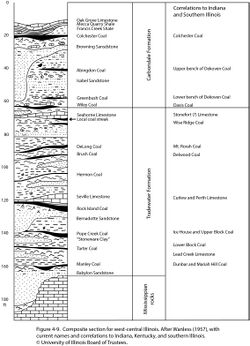Greenbush Coal Member or Bed
Lithostratigraphy: Carbondale Formation >>Greenbush Coal Member
Chronostratigraphy: Paleozoic Erathem >>Pennsylvanian Subsystem >>Desmoinesian Series
Allostratigraphy: Absaroka Sequence
Primary source
Nelson, W.J., P.H. Heckel and J.M. Obrad, 2022, Pennsylvanian Subsystem in Illinois: Illinois State Geological Survey, Bulletin (in press).
Contributing author(s)
W.J. Nelson
Name
Original description
Wanless (1931, p. 191) named the “Greenbush cyclical formation” and “Greenbush coal” together with the older Wiley cyclical formation and coal. Kosanke et al. (1960) formally designated it the Greenbush Coal Member (of the Spoon Formation).
Derivation
The name refers to Greenbush Township in Warren County, Illinois.
Other names
None.
History/background
None.
Type section
Type location
The stratotype is a ravine tributary to Swan Creek in the E½ of sec. 24, T 8 N, R 1 W, in Warren County.
Type author(s)
Wanless (1957, p. 81, 205).
Type status
Unknown.
Reference section
None has been proposed, but Wanless (1957) described several outcrop sections that might suffice. A generalized section from the area Wanless mapped in western Illinois is presented here (Figure 4-9).
Stratigraphic relationships
Wanless (1939) correlated the Greenbush with the Dekoven; Wanless (1956, 1957, 1962), Kosanke et al. (1960), and Willman et al. (1975) endorsed this correlation. Greenbush and Dekoven both occupy the second sedimentary cycle underlying the Colchester Coal (Figure 4-9). Fossil spore floras confirm the matchup of the Dekoven and Greenbush (Kosanke 1950; Peppers 1970, 1996).

The name “Greenbush” would be ripe for abandonment on the basis of redundancy were it not for the fact that the type Dekoven Coal is now known to comprise the merger of two seams. The upper of these is the Abingdon; the lower lacks a name. Because Greenbush and Abingdon long have been known as separate units in western Illinois, it is a simple matter to extend the Greenbush into southern Illinois and western Kentucky as the lower “split” of the Dekoven Coal (Figure 4-12). Where the Greenbush is distinctly separate from the Davis and Abingdon, the Greenbush is classified as a member. The Greenbush becomes a bed where it merges with the Abingdon Coal to form the Dekoven Coal Member and where it merges with both Abingdon and Davis to become the Seelyville Coal Member.
Extent and thickness
Wanless (1957, p. 82) noted that “Not more than one or two inches [≤5 cm] of Greenbush coal has been found in western Illinois.” In southeastern Illinois, Jacobson (1993) stated that the “lower split of the Dekoven” [Greenbush] is normally 1 to 2 ft (30 to 60 cm) thick but locally reaches 3 ft (90 cm).
Lithology
In western Illinois, where it is very thin, the Greenbush is shaly coal or carbonaceous shale. The thicker Greenbush (lower Dekoven) of southeastern Illinois is bright-banded coal having a moderate sulfur content and no consistent clastic layers.
Core(s)
Photograph(s)
Contacts
Both contacts are sharp or rapidly gradational.
Well log characteristics
Typical for coal.
Fossils
Kosanke (1950) and Peppers (1970, 1996) compared fossil spores of the Greenbush from western Illinois and the Dekoven Coal of southeastern Illinois and western Kentucky. The floras are closely similar, supporting the equivalence of the beds.
Age and correlation
The Greenbush is likely to be equivalent to the Robinson Branch Coal Bed of Missouri and Kansas (Figure 4-12). There is no named correlative in Iowa or the Appalachian Basin.
Environments of deposition
The Western Shelf was a positive area, barely conducive to the formation and preservation of peat. More rapid tectonic subsidence in the deeper part of the basin allowed accumulation of coal in economic thickness.
Economic importance
See the Dekoven Coal and Seelyville Coal Members.
Remarks
References
- Gentile, R.J., and T.L. Thompson, 2004, Paleozoic succession in Missouri, Part 5, Pennsylvanian Subsystem, Volume A, Morrowan strata through Cherokee Group: Missouri Geological Survey, Report of Investigations 70, 241 p. and correlation chart.
- Heckel, P.H., 2013, Pennsylvanian stratigraphy of Northern Midcontinent Shelf and biostratigraphic correlation of cyclothems: Stratigraphy, v. 10, nos. 1–2, p. 3–39.
- Jacobson, R.J., 1993, Coal resources of the Dekoven and Davis Members (Carbondale Formation) in Gallatin and Saline Counties, southeastern Illinois: Illinois State Geological Survey, Circular 551, 41 p., 5 pls.
- Kosanke, R.M., 1950, Pennsylvanian spores of Illinois and their use in correlation: Illinois State Geological Survey, Bulletin 74, 128 p., 2 pls.
- Kosanke, R.M., J.A. Simon, H.R. Wanless, and H.B. Willman, 1960, Classification of the Pennsylvanian strata of Illinois: Illinois State Geological Survey, Report of Investigations 214, 84 p. and 1 pl.
- Peppers, R.A., 1970, Correlation and palynology of coals in the Carbondale and Spoon Formations (Pennsylvanian) of the northeastern part of the Illinois Basin: Illinois State Geological Survey, Bulletin 93, 173 p.
- Peppers, R.A., 1996, Palynological correlation of major Pennsylvanian (Middle and Upper Carboniferous) chronostratigraphic boundaries in the Illinois and other coal basins: Geological Society of America, Memoir 188, 111 p. and correlation chart.
- Pope, J.P., 2012, Description of Pennsylvanian units, revision of stratigraphic nomenclature, and reclassification of the Morrowan, Atokan, Desmoinesian, Missourian, and Virgilian stages in Iowa: Iowa Geological and Water Survey, Special Report Series No. 5, 140 p.
- Wanless, H.R., 1931, Pennsylvanian cycles in western Illinois: Illinois State Geological Survey, Bulletin 60, p. 179–193.
- Wanless, H.R., 1939, Pennsylvanian correlations in the Eastern Interior and Appalachian coal fields: Geological Society of America, Special Paper 17, 130 p.
- Wanless, H.R., 1956, Classification of the Pennsylvanian rocks of Illinois as of 1956: Illinois State Geological Survey, Circular 217, 14 p.
- Wanless, H.R., 1957, Geology and mineral resources of the Beardstown, Glasford, Havana, and Vermont Quadrangles: Illinois State Geological Survey, Bulletin 82, 233 p.
- Wanless, H.R., 1962, Pennsylvanian rocks of Eastern Interior Basin, in C.C. Branson, ed., Pennsylvanian System in the United States, a symposium: Tulsa, Oklahoma, American Association of Petroleum Geologists, p. 4–59.
- Willman, H.B., E. Atherton, T.C. Buschbach, C. Collinson, J.C. Frye, M.E. Hopkins, J.A. Lineback, and J.A. Simon, 1975, Handbook of Illinois stratigraphy: Illinois State Geological Survey, Bulletin 95, 261 p.
ISGS Codes
| Stratigraphic Code | Geo Unit Designation |
|---|---|
